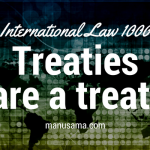In a world where sovereignty is the organizing principle and states the central subjects, the answer to the next question may look simple. How is international law made? Well, you may answer that states make the law, and that is true but only to a certain extent. As with most things, reality is more nuanced and complex. But being nuanced and admit complexity is still not cool. Yet, let me try to tell you this complex story of sources. In 1000 words or less.
Sources
For a long time it has been custom to talk about the doctrine of sources. This means the doctrine of where international law comes from and/or how it is made, which includes the question of who makes it. Article 38 of the Statute of the International Court of Justice gives a convenient list, a starting point, for answering those questions. Phrased as sources to be applied by the Court, the traditional sources of international law are:
- Treaties
- Customary international law
- General principles of law
And if these fail to provide a satisfactory answer, we look towards court decisions and the ’teachings of highly qualified publicists’, i.e. academics.
The law of treaties is a complex area in itself, so that will be covered in the next post in this series. Customary international is where nuance and complexity come in. But any of these sources is based on one main principle, and that is the consent of the state. A state cannot be bound by a rule of international law without its consent. These days the question is whether that principle still holds true. But first things first.
Customary international law
Customary law is unwritten, yet binding law. But how can we know what the norm is, and whether it is indeed law and not just a custom? First, sufficient states must display a certain level of conformity to a norm – general state practice. Second, there must be evidence that states believe that the norm is law and that they must therefore conform to it. Both criteria are obviously vague, and the exact content of the norm is never fully known until a conflict arises. With any luck, an international court of tribunal will have a say. Then, the norm can be described, circumscribed and explained. The decision will become the point of reference, a secondary source of law. But only if we’re lucky.
State practice
According to settled case law, the relevant practice of states can consist of what they say, as well as what they do. But it also matters which states we’re looking and listening to. In my classes, Austria was always the sacrificial lamb when pointing out that not the practice of all states is relevant. Case in point: Austria and the law of the sea. You can figure that one out. Nor do states need to display identical practices all the time. According to the ICJ, a ’general consistency’ in the practice of states is sufficient. Case law has brought us only a slimmer of clarity. But a determination of customary law by a court can still pop up unexpectedly at any time. Uncertainty remains, however, in determining relevant state practice.
Opinio iuris
Perhaps even more troublesome is the second criterion of a a state believing that it must do or refrain from doing something out of a legal obligation. We call it ’opinio iuris’. But how do you gauge what a state ’believes’? Ironically – and confusingly – certain actions and words of states that make up practice can also be proof of this mythical belief. Voting records in the UN, for instance, have been seen as evidence of opinio iuris. Again, it is for some authoritative bodies, like the ICJ and the International Law Commission, to determine what is customary law. Does this make things clearer? No, but welcome to customary international law.
General principles of law
The third source of international law is ’general principles of law’. These principles are the ’back up’ source for treaties and customary law. They are to be used when treaties nor customary law do not provide a clear answer to a legal problem. But as with customary law, the content of this source is equally uncertain. Do they come from international law, national law or are they innate to the concept of law? Some principles are however certain and may sound familiar: good faith, equity, obligation to provide reparation for violating the law. At the same time, general principles are based on consensus, not so much on consent. At least not explicitly.
Hierarchy
Buut what if the primary sources – treaties and customary law – say contradictory things? Or when they say the same? Which source prevails? There is no deciding rule, only two rules of thumb to assist with the answer. First, the new source goes before the older one. And second, the more particular source prevails over the general one. That is, the source that regulates the issue a hand more specifically should determine it. And I must repeat: it is a matter of judgement, ordinarily made by a judge. Sounds familiar, right?
Sources v. law-making
There is something to be said for the idea that the doctrine of sources and the principle of consent are out of date. First, with the countless actions of states and interactions between them, any consent to the development of international law starts to become untraceable. To insist that consent is still the basis for the binding character of customary law is theoretical at best, and artificial at worst. General principles cannot be really grounded in consent either. Law is now made, and governance is done through a variety of transnational and informal structures. Governmental- and non-governmental organizations, corporation, and individuals all contribute to the development of norms. International law is not so much found from sources, but made by all those engaged in the system.
Anything unclear? I would appreciate any feedback in the comments below, or through Facebook or Twitter!



